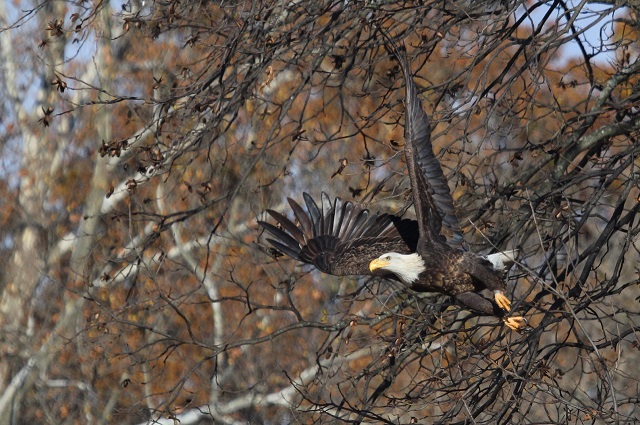
Winter has already given us record setting low temperatures in many areas of the state and all-time record highs for the season, all in the same week. A reminder that the old Will Rogers quip, “If you don’t like the weather in Oklahoma, wait a minute and it’ll change,” still holds true as we prepare for the next round of winter weather on a beautiful sunny, 70 degree day inshorts and t-shirts.
The aviary sits near the edge of what many forecasters are calling the freezing boundary as a rain moves into the area over the weekend. Rain, sleet, ice or snow the eagles are prepared and while our weather may be unpredictable, Wadasé Zhabwé has not been. She continues to return to the area in and around the aviary every two to three weeks. She has established several 40-50 mile routes that she follows as she makes her way from one familiar hunting ground to the next. She stays at these locations for several days before making the trip back towards home. Although, the last time she was at the aviary was the first week in December, she has been within a few miles of the aviary and that timing is right on schedule with her previous visits.
We are seeing more wintering bald eagles in the state and we have seen several pairs already at many of the nest sites we monitor. But Wadasé continues to roam. She frequents her favorite places along the river but never remains in one area for too long, all indications that she will not nest this season. Bald eagles reach maturity at four to five years of age but not all nest immediately. Even though Wadasé is five this year, she was injured and spent nearly a year at the aviary before she was released, and her experience in the wild was delayed slightly. However, it is possible that she could still find a potential mate this season. We will still keep an eye out for her potential plus one.
Wadasé’s telemetry backpack continues to give us consistent data and although she was not expected to still be wearing the unit we are hoping for many more seasons of telemetry. One of our long term goals, if we are fortunate enough to know the location she chooses, is to install a nest camera that would allow us to continue sharing her story for many years even without telemetry. The idea of watching one of our own Bodéwadmi (Potawatomi) nest is exciting. Until then there are many active nest cameras across the country with thousands of people watching daily. Because of the different weather patterns across the U.S. nesting times for bald eagles vary greatly depending on location.
Northern bald eagles typically nest in February or April while those in the south begin to nest in December and January. Wadasé was found in central Florida and there are two great nest cameras there that have already hatched young this season. If you would like to watch an eagle hatch there are a couple of nest cameras in Iowa where the eagles are just beginning to work on the nest for the season and those eggs are typically laid the second week in February. But we must caution readers up front, viewing can be highly addictive.
www.dickpritchettrealestate.com/eagle-feed.html www.dickpritchettrealestate.com/eagle-feed.html
South Florida Nest Cams
As always we encourage you to keep your eyes out for Wadasé if you are near the areas she frequents. For more information about the CPN Eagle Aviary or to read previous Wadasé updates visit www.potawatomiheritage.org.
Send your encounters with Wadasé or any other eagles in Oklahoma or wherever you may be to us at aviary@potawatomi.org. Those reports have been a valuable tool in tracking her progress and locating nest sites around the state.
